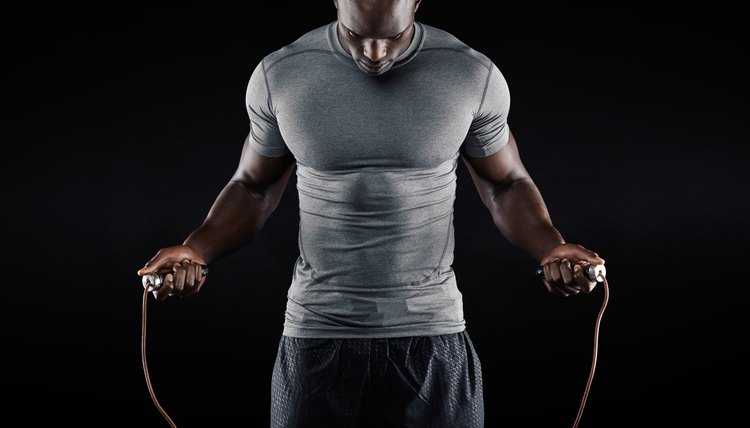Defensive Line Off-Season Workouts

Playing defensive line on a football team requires a mixture of strength, agility and speed, and each can be developed and improved with off-season workouts. An effective off-season workout routine should provide you with a combination of strength building, muscular endurance and cardiovascular training activities.
Strength Training
A defensive lineman constantly uses his muscles while performing the bulk of his responsibilities, which include tackling, chasing ball carriers and putting pressure on the quarterback by locking horns with equally big and strong offensive linemen. A player’s core muscles, including the lower back, hip and abdominal muscles, provide the stability and balance needed to outmaneuver and tackle opposing players. It makes sense to strengthen and enhance these muscles through a variety of strength-training exercises, including bench presses, squats, curls, dead lifts and crunches. Every day you spend in the weight room should include a workout for each of the major muscle groups, and this should not be done on consecutive days. At least a day’s rest is needed to allow the muscle tissue to repair itself from a workout and, in the process, increase muscle mass, which translates into stronger muscles.
Running
Few defensive linemen enjoy running, but it is a crucial element of the game. It can be the difference between on-field success and riding the pine. Long-distance and short-distance running, such as sprints, are important elements of an off-season workout that should be done at least three times a week for 30 minutes to an hour per session. When running long distance, end each session by increasing speed until you are in a full sprint during the final 100 yards of the run. Keep your sprints at a distance of 100 yards or less, focusing on sprints of 10 to 20 yards, common distances covered by a defensive lineman during the course of a football game.
Court Games
Court games, such as basketball, tennis, squash and racquetball, are ideal for a defensive lineman’s off-season workout regimen thanks to their ability to help develop agility and muscular endurance. Racquetball, for instance, requires short bursts of speed and a lot of twisting and turning, moves used extensively during a football game. Basketball gives you the chance to develop the core and leg muscles by rebounding, boxing out and running. Similar to racquetball, tennis involves a lot of lateral movement and helps improve hand-eye coordination, which can come in handy when chasing down a running back. Implement court games into your off-season routine at least once or twice per week.
Jumping Rope and Swimming
Jumping rope will improve your hand-eye-foot coordination and agility while providing an effective cardiovascular workout. According to the Jump Rope Institute, 10 minutes of rapid rope jumping burns as many calories as 30 minutes of jogging and 720 yards of swimming. Swimming provides a full-body workout that works each of the body’s major muscle groups. It's an effective way to tone muscles without the influence of body weight. Jumping rope and swimming should be used as regular components of a defensive lineman’s off-season workout routine and should be engaged in at least twice a week for optimal results.
References
Writer Bio
Lou Martin has been writing professionally since 1992. His work has appeared in the "Los Angeles Times," the "Long Beach Press-Telegram" and the "Deseret Morning News." Martin holds a Bachelor of Science in history and communication.
